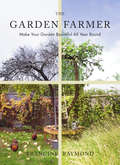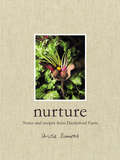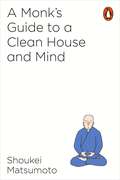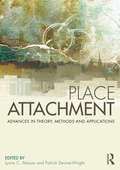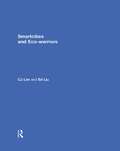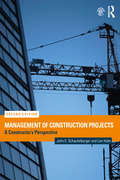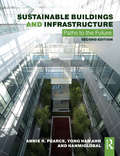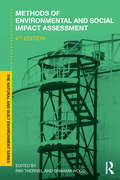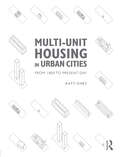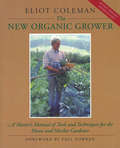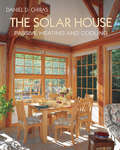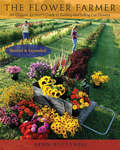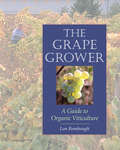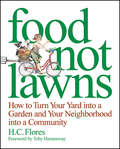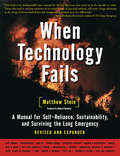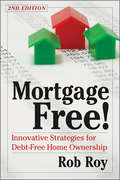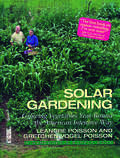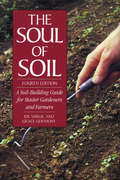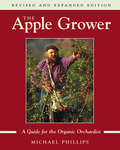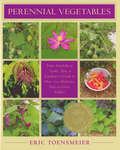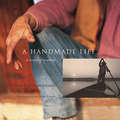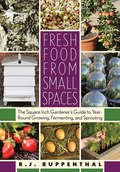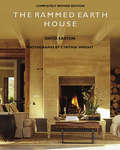- Table View
- List View
The Garden Farmer
by Francine RaymondSelected as a Book of the Year 2017 in You Magazine'A lavish monthly guide to getting the most from your garden' Daily MailA punnet of plums from your tree, a handful of gooseberries; home-grown nuts and herbs, and a few freshly laid eggs from your hens – all enjoyed in your own small plot. What could be more satisfying?The Garden Farmer is an evocative journal and monthly guide to getting the most out of your garden throughout the year. Whether you are a keen gardener looking for inspiration, or just starting out and wanting to rediscover and reclaim your patch of earth, Sunday Telegraph garden-columnist Francine Raymond lays the groundwork for a bountiful year of garden farming. Maybe you would like to get outside more, grow a few essential vegetables, some fruit trees or bushes for preserving, and create a scented kitchen garden to provide for you year round. Or perhaps you will raise a small flock of ducks or geese, or even a couple of pigs? Could this be the year you decorate your home with nature’s adornments, encourage wildlife back to pollinate your trees and plants, and spend celebratory hours in a haven of your own creation? Each chapter of The Garden Farmer offers insight into the topics and projects you might be contemplating that month, along with planting notes and timely advice, and a recipe that honours the fruits of your labour. With just a little effort and planning, every garden can be tended in tune with nature, and every gardener can enjoy a host of seasonal delights from their own soil.Keep up-to-date with Francine's gardening adventures on her blog at kitchen-garden-hens.co.uk.
Nurture: Notes and Recipes from Daylesford Farm
by Carole BamfordOver 40 years ago, Carole Bamford began a journey towards a more conscious way of life. What began as a desire to make a small difference to the health and future of our planet has grown from a collection of empty barns, bare fields and a small herd of dairy cows, to become Daylesford Organic, one of the most sustainable farms in the UK.Nurture tells the story of how and why it all began and brings to life the principles, ideas and beliefs that have made Daylesford what it is today. From sustainable farming to holistic health, Nurture shares Carole Bamford’s vision for a more mindful way of life and how we can all nourish our bodies, mind and spirit in a simple and balanced way. At the heart of Daylesford is its connection to the land and the book also celebrates the bountiful organic produce it reaps with a selection of seasonal recipes. Packed with flavour and nourishing ingredients, choose from colourful salads and hearty stews, indulgent puddings, meals for special occasions and food for those times when you need an additional boost of nutrients. Nurture is a celebration of the bounty that nature provides, and a reminder that we must all take care of the land we live off, so that future generations can enjoy its riches too.
A Monk's Guide to a Clean House and Mind: Housekeeping Secrets From The World's Tidiest Monks
by Shoukei MatsumotoCleanliness is next to enlightenment. In this Japanese bestseller a Buddhist monk explains the traditional cleaning techniques that will help cleanse not only your house - but your soul.'We remove dust to sweep away our worldly desires. We scrub dirt to free ourselves of attachments. We live simply and take time to contemplate the self, mindfully living each moment. It's not just monks that need to live this way. Everyone in today's busy world today needs it.The Zen sect of Buddhism is renowned for the cleanliness of its monks, but cleaning is greatly valued in Japanese Buddhism in general as a way to cultivate the mind. In this book, I introduce everyday cleaning methods typically employed in temples, while sharing what it's like to be a monk in training.This book will improve the condition not just of your own mind, but also the people around you. I hope readers will discover that cleanliness is an opportunity to contemplate oneself.'
Place Attachment: Advances in Theory, Methods and Applications
by Lynne C. Manzo Patrick Devine-WrightRecipient of the 2014 EDRA Achievement Award. Place attachments are emotional bonds that form between people and their physical surroundings. These connections are a powerful aspect of human life that inform our sense of identity, create meaning in our lives, facilitate community and influence action. Place attachments have bearing on such diverse issues as rootedness and belonging, placemaking and displacement, mobility and migration, intergroup conflict, civic engagement, social housing and urban redevelopment, natural resource management and global climate change. In this multidisciplinary book, Manzo and Devine-Wright draw together the latest thinking by leading scholars from around the globe, capturing important advancements in three areas: theory, methods and application. In a wide range of conceptual and applied ways, the authors critically review and challenge contemporary knowledge, identify significant advances and point to areas for future research. This volume offers the most current understandings about place attachment, a critical concept for the environmental social sciences and placemaking professions.
Place Attachment: Advances in Theory, Methods and Applications
by Lynne C. Manzo Patrick Devine-WrightRecipient of the 2014 EDRA Achievement Award. Place attachments are emotional bonds that form between people and their physical surroundings. These connections are a powerful aspect of human life that inform our sense of identity, create meaning in our lives, facilitate community and influence action. Place attachments have bearing on such diverse issues as rootedness and belonging, placemaking and displacement, mobility and migration, intergroup conflict, civic engagement, social housing and urban redevelopment, natural resource management and global climate change. In this multidisciplinary book, Manzo and Devine-Wright draw together the latest thinking by leading scholars from around the globe, capturing important advancements in three areas: theory, methods and application. In a wide range of conceptual and applied ways, the authors critically review and challenge contemporary knowledge, identify significant advances and point to areas for future research. This volume offers the most current understandings about place attachment, a critical concept for the environmental social sciences and placemaking professions.
Smartcities and Eco-Warriors: The Ecological Landscapes For Urban Resilience
by Cj Lim Ed LiuModern methods of agriculture have led to cities growing out of control and reducing the available agricultural land, threatening the sustainability of our food system. The previous mutually sustaining relationships of animals, humans and the land have been lost with the progress of industry. The Smartcity – an ecological symbiosis between nature, society and the built form – is the innovative response to contemporary problems from one of the world’s leading urban design and architectural thinkers. Addressing the problems of unchecked city growth, the idea of the Smartcity questions whether we could begin to live once again from first principles, focusing in on the inhabitants of the city. The holistic construct of the Smartcity is developed through a series of international case studies, some commissioned by government organisations, others speculative and polemic. Reframing the way people think about urban green space and the evolution of cities, CJ Lim and Ed Liu explore how the reintegration of agriculture in urban environments can cultivate new spatial practices and social cohesion in addition to food for our tables. Representing an emerging architectural voice in matters of environmental and social sustainability, Smartcities and Eco-warriors is a long overdue treatment of the subject from a designer’s perspective, and is essential reading for practitioners and students in the fields of architecture, urban planning, environmental engineering, landscape design, agriculture and sociology. An inspiration to government agencies and NGOs dealing with climate change, it also resonates with anyone concerned about cities, energy conservation and the future of food
Smartcities and Eco-Warriors
by Cj Lim Ed LiuModern methods of agriculture have led to cities growing out of control and reducing the available agricultural land, threatening the sustainability of our food system. The previous mutually sustaining relationships of animals, humans and the land have been lost with the progress of industry. The Smartcity – an ecological symbiosis between nature, society and the built form – is the innovative response to contemporary problems from one of the world’s leading urban design and architectural thinkers. Addressing the problems of unchecked city growth, the idea of the Smartcity questions whether we could begin to live once again from first principles, focusing in on the inhabitants of the city. The holistic construct of the Smartcity is developed through a series of international case studies, some commissioned by government organisations, others speculative and polemic. Reframing the way people think about urban green space and the evolution of cities, CJ Lim and Ed Liu explore how the reintegration of agriculture in urban environments can cultivate new spatial practices and social cohesion in addition to food for our tables. Representing an emerging architectural voice in matters of environmental and social sustainability, Smartcities and Eco-warriors is a long overdue treatment of the subject from a designer’s perspective, and is essential reading for practitioners and students in the fields of architecture, urban planning, environmental engineering, landscape design, agriculture and sociology. An inspiration to government agencies and NGOs dealing with climate change, it also resonates with anyone concerned about cities, energy conservation and the future of food
Management of Construction Projects: A Constructor's Perspective
by John E. Schaufelberger Len HolmUnlike the majority of construction project management textbooks out there, Management of Construction Projects takes a distinctive approach by setting itself in the context of a single and real-world construction project throughout and also by looking at construction project management from the constructor’s perspective. This project-based learning approach emphasizes the skills, knowledge, and techniques students require to become successful project managers. This second edition uses a brand new, larger, and more challenging case study to take students through key stages of the process, including: contracts and subcontracting; estimating, scheduling, and planning; supply chain and materials management; cost control, quality, and safety; project leadership and ethics; and claims, disputes, and project close-outs. Also new to this edition is coverage of emergent industry trends such as LEAN, LEED, and BIM. The book contains essential features such as review questions, exercises, and chapter summaries, while example plans, schedules, contracts, and other documents are stored on a companion website. Written in straightforward language from a constructor’s perspective, this textbook gives a realistic overview and review of the roles of project managers and everything they need to know in order to see a successful project through from start to finish.
Sustainable Buildings and Infrastructure: Paths to the Future
by Annie R. Pearce Yong Han Ahn HanmiGlobal Co, LtdThe second edition of Sustainable Buildings and Infrastructure continues to provide students with an introduction to the principles and practices of sustainability as they apply to the construction sector, including both buildings and infrastructure systems. As a textbook, it is aimed at students taking courses in construction management and the built environment, but it is also designed to be a useful reference for practitioners involved in implementing sustainability in their projects or firms. Case studies, best practices and highlights of cutting edge research are included throughout, making the book both a core reference and a practical guide.
Methods of Environmental and Social Impact Assessment (Natural and Built Environment Series)
by Peter Morris Riki Therivel Graham WoodEnvironmental and social impact assessment (ESIA) is an important and often obligatory part of proposing or launching any development project. Delivering a successful ESIA needs not only an understanding of the theory but also a detailed knowledge of the methods for carrying out the processes required. Riki Therivel and Graham Wood bring together the latest advice on best practice from experienced practitioners to ensure an ESIA is carried out effectively and efficiently. This new edition: • explains how an ESIA works and how it should be carried out • demonstrates the links between socio-economic, cultural, environmental and ecological systems and assessments • incorporates the World Bank’s IFC performance standards, and best practice examples from developing as well as developed countries • includes new chapters on emerging ESIA topics such as climate change, ecosystem services, cultural impacts, resource efficiency, land acquisition and involuntary resettlement. Invaluable to undergraduate and MSc students of ESIA on planning, ecology, geography and environment courses, this internationally oriented fourth edition of Methods of Environmental and Social Impact Assessment is also of great use to planners, ESIA practitioners and professionals seeking to update their skills.
Multi-Unit Housing in Urban Cities: From 1800 to Present Day
by Katy CheyThis book investigates the development of multi-unit housing typologies that were predominant in a particular city from the 1800s to present day. It emphasises the importance of understanding the direct connection between housing and dwelling in the context of a city, and the manner in which the city is an instructional indication of how a housing typology is embodied. The case studies presented offer an insight into why a certain housing type flourished in a specific city and the variety span across cities in the world where distinct housing types have prevailed. It also pursues how housing types developed, evolved, and helped define the city, looks into how dwellers inhabited their dwellings, and analyses how the housing typologies correlates in a contemporary context. The typologies studied are back-to-backs in Birmingham; tenements in London; Haussmann Apartment in Paris; tenements in New York; tong lau in Hong Kong; perimeter block, linear block, and block-edge in Berlin; perimeter block and solitaire in Amsterdam; space-enclosing structure in Beijing; micro house in Tokyo, and high-rise in Toronto.
The New Organic Grower: A Master's Manual of Tools and Techniques for the Home and Market Gardener, 2nd Edition
by Eliot Coleman Sheri Amsel Molly Cook FieldWith more than 45,000 sold since 1989, The New Organic Grower has become a modern classic. In this newly revised and expanded edition, master grower Eliot Coleman continues to present the simplest and most sustainable ways of growing top-quality organic vegetables. Coleman updates practical information on marketing the harvest, on small-scale equipment, and on farming and gardening for the long-term health of the soil. The new book is thoroughly updated, and includes all-new chapters such as: Farm-Generated Fertility—how to meet your soil-fertility needs from the resources of your own land, even if manure is not available. The Moveable Feast—how to construct home-garden and commercial-scale greenhouses that can be easily moved to benefit plants and avoid insect and disease build-up. The Winter Garden—how to plant, harvest, and sell hardy salad crops all winter long from unheated or minimally heated greenhouses. Pests—how to find "plant-positive" rather than "pest-negative" solutions by growing healthy, naturally resistant plants. The Information Resource—how and where to learn what you need to know to grow delicious organic vegetables, no matter where you live. Written for the serious gardener or small market farmer, The New Organic Grower proves that, in terms of both efficiency and profitability, smaller can be better.
The Solar House: Passive Heating and Cooling (Real Goods Solar Living Bks.)
by Daniel D. ChirasPassive solar heating and passive cooling—approaches known as natural conditioning—provide comfort throughout the year by reducing, or eliminating, the need for fossil fuel. Yet while heat from sunlight and ventilation from breezes is free for the taking, few modern architects or builders really understand the principles involved. Now Dan Chiras, author of the popular book The Natural House, brings those principles up to date for a new generation of solar enthusiasts. The techniques required to heat and cool a building passively have been used for thousands of years. Early societies such as the Native American Anasazis and the ancient Greeks perfected designs that effectively exploited these natural processes. The Greeks considered anyone who didn't use passive solar to heat a home to be a barbarian! In the United States, passive solar architecture experienced a major resurgence of interest in the 1970s in response to crippling oil embargoes. With grand enthusiasm but with scant knowledge (and sometimes little common sense), architects and builders created a wide variety of solar homes. Some worked pretty well, but looked more like laboratories than houses. Others performed poorly, overheating in the summer because of excessive or misplaced windows and skylights, and growing chilly in the colder months because of insufficient thermal mass and insulation and poor siting. In The Solar House, Dan Chiras sets the record straight on the vast potential for passive heating and cooling. Acknowledging the good intentions of misguided solar designers in the past, he highlights certain egregious—and entirely avoidable—errors. More importantly, Chiras explains in methodical detail how today's home builders can succeed with solar designs. Now that energy efficiency measures including higher levels of insulation and multi-layered glazing have become standard, it is easier than ever before to create a comfortable and affordable passive solar house that will provide year-round comfort in any climate. Moreover, since modern building materials and airtight construction methods sometimes result in air-quality and even toxicity problems, Chiras explains state-of-the-art ventilation and filtering techniques that complement the ancient solar strategies of thermal mass and daylighting. Chiras also explains the new diagnostic aids available in printed worksheet or software formats, allowing readers to generate their own design schemes.
The Flower Farmer: An Organic Grower's Guide to Raising and Selling Cut Flowers, 2nd Edition
by Lynn Byczynski Robin WimbiscusThe domestic cut flower business has experienced a renaissance in the past decade, thanks in large part to the first edition of The Flower Farmer: An Organic Grower’s Guide to Raising and Selling Cut Flowers, which helped thousands of small growers start successful businesses. This newly expanded and thoroughly revised edition will be equally as influential for novices and experienced growers alike. With the cut flower business growing at record rates, demand is at all time highs, challenging growers to take advantage of new techniques to prolong the harvest. New sections on utilizing greenhouses, recommendations for flower cultivars, and post harvest handling growers throughout all of North America will help improve their bottom line. Also updated is the acclaimed resource directory, complete with sources of seeds, plants and supplies, and expert information on organic production under the National Organic Program. For the beginner and backyard gardener, there is an extensive section on the basics—variety selection, soil preparation, planting, cultivation, harvest, and floral design. For the commercial grower, The Flower Farmer includes information about larger-scale production, plus advice about selling to florists, wholesalers, supermarkets, brides, at farmers markets, and more. Also includes revised profiles of successful growers offering behind-the-scenes insight into the operation of some of the cutting edge flower farmers in the country. Because of the extensive revisions and enhanced content, this new edition of The Flower Farmer is essential reading for those already in the flower business, as well as those who dream of growing flowers for enjoyment or profit.
The Grape Grower: A Guide to Organic Viticulture (The\house That Jack Built Ser.)
by Lon Rombough Roger B. SwainGrapes are the most popular and widely grown fruit in the world. From the tropics to Alaska, grapes will grow successfully in almost every climate. Whether you raise them for fresh eating, or for making wine, juice, or jellies and preserves, the right grapes will reward you with abundant crops for a modest investment of time and effort. Now for the first time comes a book for grape growers who wish to use organic growing methods to raise healthy, thriving vineyards in the backyard or on a small commercial scale. The Grape Grower distills the broad knowledge and long-time personal experience of Lon Rombough, one of North America's foremost authorities on viticulture. From finding and preparing the right site for your vineyard to training, trellising, and pruning vines to growing new grapes from seeds and cuttings, The Grape Grower offers thorough and accessible information on all the basics. The chapters on grape species, varieties, and hybrids are alone worth the price of a college course in viticulture. Technical information on the major (and minor) insect pests and diseases that affect grapes, as well as their organic controls, makes this book an invaluable reference that readers will turn to again and again. Rombaugh also provides a wealth of information on hardy but little-known grapes that are native to North America, and on a wide range of topics, including: pruning neglected or overgrown vines growing grapes on arbors and in greenhouses controlling animal pests in the vineyard bunch grapes and muscadine grapes for the South winter protection, and how to increase the hardiness of grapes creating your own new varieties
Food Not Lawns: How to Turn Your Yard into a Garden and Your Neighborhood into a Community
by Heather Jo Flores Toby HemenwayGardening can be a political act. Creativity, fulfillment, connection, revolution—it all begins when we get our hands in the dirt. Food Not Lawns combines practical wisdom on ecological design and community-building with a fresh, green perspective on an age-old subject. Activist and urban gardener Heather Flores shares her nine-step permaculture design to help farmsteaders and city dwellers alike build fertile soil, promote biodiversity, and increase natural habitat in their own "paradise gardens." But Food Not Lawns doesn't begin and end in the seed bed. This joyful permaculture lifestyle manual inspires readers to apply the principles of the paradise garden—simplicity, resourcefulness, creativity, mindfulness, and community—to all aspects of life. Plant "guerilla gardens" in barren intersections and medians; organize community meals; start a street theater troupe or host a local art swap; free your kitchen from refrigeration and enjoy truly fresh, nourishing foods from your own plot of land; work with children to create garden play spaces. Flores cares passionately about the damaged state of our environment and the ills of our throwaway society. In Food Not Lawns, she shows us how to reclaim the earth one garden at a time.
When Technology Fails: A Manual for Self-Reliance, Sustainability, and Surviving the Long Emergency, 2nd Edition
by Matthew SteinThere’s never been a better time to “be prepared.” Matthew Stein’s comprehensive primer on sustainable living skills—from food and water to shelter and energy to first-aid and crisis-management skills—prepares you to embark on the path toward sustainability. But unlike any other book, Stein not only shows you how to live “green” in seemingly stable times, but to live in the face of potential disasters, lasting days or years, coming in the form of social upheaval, economic meltdown, or environmental catastrophe. When Technology Fails covers the gamut. You’ll learn how to start a fire and keep warm if you’ve been left temporarily homeless, as well as the basics of installing a renewable energy system for your home or business. You’ll learn how to find and sterilize water in the face of utility failure, as well as practical information for dealing with water-quality issues even when the public tap water is still flowing. You’ll learn alternative techniques for healing equally suited to an era of profit-driven malpractice as to situations of social calamity. Each chapter (a survey of the risks to the status quo; supplies and preparation for short- and long-term emergencies; emergency measures for survival; water; food; shelter; clothing; first aid, low-tech medicine, and healing; energy, heat, and power; metalworking; utensils and storage; low-tech chemistry; and engineering, machines, and materials) offers the same approach, describing skills for self-reliance in good times and bad. Fully revised and expanded—the first edition was written pre-9/11 and pre-Katrina, when few Americans took the risk of social disruption seriously—When Technology Fails ends on a positive, proactive note with a new chapter on "Making the Shift to Sustainability," which offers practical suggestions for changing our world on personal, community and global levels.
Mortgage Free!: Innovative Strategies for Debt-Free Home Ownership, 2nd Edition
by Robert L. Roymort•gage (mor´-gij) n. from Old French morgage, mort gage, literally “death pledge” As a wave of foreclosures sweeps the country, many people are giving up hope for owning a home of their own. They have good reason to turn their backs on the banks, but not on their dreams. In this revised edition of Mortgage Free!, Rob Roy offers a series of escape routes from enslavement to financial institutions, underscored by true stories of intrepid homeowners who have put their principles into action. From back-to-the-land homesteads to country homes, here is a complete guide to strategies that allow you to own your land and home, free and clear, without the bank. Included is detailed advice about: Clarifying and simplifying your notions of what’s necessary Finding land that you love and can afford Taking control of the house-building process, for the sake of sanity and pleasure Learning to take a long-term perspective on your family’s crucial economic decisions, avoiding debt and modern-day serfdom
Solar Gardening: Growing Vegetables Year-Round the American Intensive Way (Real Goods Independent Living Bks.a\real Goods Independent Living Book)
by Leandre Poisson Gretchen Vogel Poisson Robin WimbiscusSolar Gardening shows how to increase efforts of the sun during the coldest months of the year and how to protect tender plants from the intensity of the scorching sun during the hottest months through the use of solar "mini-greenhouses." The book includes instructions for building a variety of solar appliances plus descriptions of more than 90 different crops, with charts showing when to plant and harvest each. The result is a year-round harvest even from a small garden. In Solar Gardening the Poissons show you how to: Dramatically increase the annual square-foot yield of your garden. Extend the growing and harvest season for nearly every kind of vegetable. Select crops that will thrive in the coldest and hottest months of the year, without artificial heating or cooling systems. Build solar appliances for your own garden. Armed with nothing but this book and a few simple tools, even novice gardeners can quickly learn to extend their growing season and increase their yields, without increasing the size of their garden plot.
The Soul of Soil: A Soil-Building Guide for Master Gardeners and Farmers, 4th Edition
by Joseph Smillie Grace GershunySoil is the basis not only for all gardening, but for all terrestrial life. No aspect of agriculture is more fundamental and important, yet we have been losing vast quantities of our finite soil resources to erosion, pollution, and development. Now back in print, this eminently sensible and wonderfully well-focused book provides essential information about one of the most significant challenges for those attempting to grow delicious organic vegetables: the creation and maintenance of healthy soil. Chapter 2, "Understanding the Soil System," is alone worth the price of admission. Gershuny and Smillie give lay readers and experts a clear explanation of subjects--soil life and nutrient cycles--that have confounded most authors. Nowhere will the reader find simpler and more coherent descriptions of key concepts including cation exchange capacity and chelation. There are other books about soil available, including Grace Gershuny's comprehensive Start with the Soil, and there are books that feature chapters on soil building. What distinguishes The Soil of Soilis the authors' concise presentation; they give readers important information, including technical essentials, without getting bogged down in scientific or quasiscientific mumbo-jumbo. In addition, useful tables list specific compost materials, green manures, and other resources that allow growers to translate into action the more general information provided by the book. The soil-building techniques featured include: Organic matter management Building and maintaining humus On-site composting Green manures and rotations Cultivation and weed control Nutrient balances and soil testing Using mineral fertilizers Planning for organic certification Updates to the 1999 edition include analysis of Proposed Rules for the National Organic Standards, and expanded recommendations for private testing services and soil-testing equipment for home gardeners and organic farmers. All of us involved in the cultivation of plants--from the backyard gardener to the largest farmer--need to help regenerate a "living soil," for only in the diversity of the soil and its creatures can we ensure the long-term health of ourselves and our environment. The Soul of Soil offers everyone a basic understanding of what soil is and what we can do to improve our own patch of it. Seen in this light, this practical handbook will be an inspiration as well.
The Apple Grower: Guide for the Organic Orchardist, 2nd Edition
by Michael PhillipsFor decades fruit growers have sprayed their trees with toxic chemicals in an attempt to control a range of insect and fungal pests. Yet it is possible to grow apples responsibly, by applying the intuitive knowledge of our great-grandparents with the fruits of modern scientific research and innovation. Since The Apple Grower first appeared in 1998, orchardist Michael Phillips has continued his research with apples, which have been called "organic's final frontier." In this new edition of his widely acclaimed work, Phillips delves even deeper into the mysteries of growing good fruit with minimal inputs. Some of the cuttingedge topics he explores include: The use of kaolin clay as an effective strategy against curculio and borers, as well as its limitations Creating a diverse, healthy orchard ecosystem through understory management of plants, nutrients, and beneficial microorganisms How to make a small apple business viable by focusing on heritage and regional varieties, value-added products, and the "community orchard" model The author's personal voice and clear-eyed advice have already made The Apple Grower a classic among small-scale growers and home orchardists. In fact, anyone serious about succeeding with apples needs to have this updated edition on their bookshelf.
Perennial Vegetables: From Artichokes to Zuiki Taro, A Gardener's Guide to Over 100 Delicious and Easy to Grow Edibles
by Eric ToensmeierThere is a fantastic array of vegetables you can grow in your garden, and not all of them are annuals. In Perennial Vegetables the adventurous gardener will find information, tips, and sound advice on less common edibles that will make any garden a perpetual, low-maintenance source of food. Imagine growing vegetables that require just about the same amount of care as the flowers in your perennial beds and borders—no annual tilling and potting and planting. They thrive and produce abundant and nutritious crops throughout the season. It sounds too good to be true, but in Perennial Vegetables author and plant specialist Eric Toensmeier (Edible Forest Gardens) introduces gardeners to a world of little-known and wholly underappreciated plants. Ranging beyond the usual suspects (asparagus, rhubarb, and artichoke) to include such "minor" crops as ground cherry and ramps (both of which have found their way onto exclusive restaurant menus) and the much sought after, anti-oxidant-rich wolfberry (also known as goji berries), Toensmeier explains how to raise, tend, harvest, and cook with plants that yield great crops and satisfaction. Perennial vegetables are perfect as part of an edible landscape plan or permaculture garden. Profiling more than 100 species, illustrated with dozens of color photographs and illustrations, and filled with valuable growing tips, recipes, and resources, Perennial Vegetables is a groundbreaking and ground-healing book that will open the eyes of gardeners everywhere to the exciting world of edible perennials.
A Handmade Life: In Search of Simplicity
by William Coperthwaite Peter Forbes John SaltmarshWilliam Coperthwaite is a teacher, builder, designer, and writer who for many years hasexplored the possibilities of true simplicity on a homestead on the north coast of Maine. In the spirit of Henry David Thoreau, Emily Dickinson, and Helen and Scott Nearing, Coperthwaite has fashioned a livelihood of integrity and completeness-buying almost nothing, providing for his own needs, and serving as a guide and companion to hundreds of apprentices drawn to his unique way of being. A Handmade Life carries Coperthwaite's ongoing experiments with hand tools, hand-grown and gathered food, and handmade shelter, clothing, and furnishings out into the world to challenge and inspire. His writing is both philosophical and practical, exploring themes of beauty, work, education, and design while giving instruction on the hand-crafting of the necessities of life. Richly illustrated with luminous color photographs by Peter Forbes, the book is a moving and inspirational testament to a new practice of old ways of life.
Fresh Food from Small Spaces: The Square-Inch Gardener's Guide to Year-Round Growing, Fermenting, and Sprouting
by R. J. RuppenthalBooks on container gardening have been wildly popular with urban and suburban readers, but until now, there has been no comprehensive "how-to" guide for growing fresh food in the absence of open land. Fresh Food from Small Spaces fills the gap as a practical, comprehensive, and downright fun guide to growing food in small spaces. It provides readers with the knowledge and skills necessary to produce their own fresh vegetables, mushrooms, sprouts, and fermented foods as well as to raise bees and chickens—all without reliance on energy-intensive systems like indoor lighting and hydroponics. Readers will learn how to transform their balconies and windowsills into productive vegetable gardens, their countertops and storage lockers into commercial-quality sprout and mushroom farms, and their outside nooks and crannies into whatever they can imagine, including sustainable nurseries for honeybees and chickens. Free space for the city gardener might be no more than a cramped patio, balcony, rooftop, windowsill, hanging rafter, dark cabinet, garage, or storage area, but no space is too small or too dark to raise food. With this book as a guide, people living in apartments, condominiums, townhouses, and single-family homes will be able to grow up to 20 percent of their own fresh food using a combination of traditional gardening methods and space-saving techniques such as reflected lighting and container "terracing." Those with access to yards can produce even more. Author R. J. Ruppenthal worked on an organic vegetable farm in his youth, but his expertise in urban and indoor gardening has been hard-won through years of trial-and-error experience. In the small city homes where he has lived, often with no more than a balcony, windowsill, and countertop for gardening, Ruppenthal and his family have been able to eat at least some homegrown food 365 days per year. In an era of declining resources and environmental disruption, Ruppenthal shows that even urban dwellers can contribute to a rebirth of local, fresh foods.
The Rammed Earth House: Revised Edition (Real Goods Independent Living Bks.)
by David Easton Cynthia WrightThe Rammed Earth House is an eye-opening example of how the most dramatic innovations in home design and construction frequently have their origins in the distant past. By rediscovering the most ancient of all building materials —earth—forward-thinking homebuilders can now create structures that set new standards for beauty, durability, and efficient use of natural resources. Rammed earth construction is a step forward into a sustainable future, when homes will combine pleasing aesthetics and intense practicality with a powerful sense of place. Rammed earth homes are built entirely on-site, using basic elements—earth, water, and a little cement. The solid masonry walls permit design flexibility while providing year-round comfort and minimal use of energy. The builder and resident of a rammed earth house will experience the deep satisfaction of creating permanence in a world dominated by the disposable.
